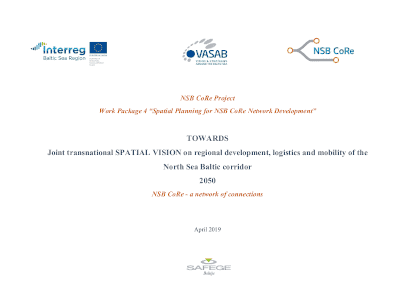NSB CoRe
Lower accessibility of eastern parts
The eastern part of the Baltic Sea region is marked by lower connectivity and accessibility. Especially in the cross-border areas and inter-urban growth corridor sections, there is considerable potential for developing transport options.
Multiple challenges in passenger transport
Due to low population density, the transport relies on combined infrastructures for freight and passengers. Road transport and short sea shipping prevail while rail transport strives to gain momentum.
Connectivity and accessibility in cross border areas is lagging behind as the development has rather been targeting main urban nodes and routes. The biggest missing link is the railway connection from Tallinn, Riga, Kaunas towards Warsaw. The implementation of Rail Baltica, a railway infrastructure venture that links Finland, Estonia, Latvia, Lithuania and Poland with a European standard rail line, is expected to solve the missing link between north and south, and ensure better connectivity in the region.
However, the biggest volumes in freight are still on the east-west routes. In passenger transport, the main challenge is how to develop multimodal transport: increase the share of public transport, develop smart transport solutions, multimodal mobile services and mobility as a service. This would contribute to supporting the economic growth corridors and zones of intensified commuting.
On top, regional planning systems are usually inward-looking and node-centric. The challenge is on one hand to bring cross-border issues and on the other hand to bring the trans-national corridor perspective into the spatial planning processes.
Budgets
in numbers
-
3.31MillionTotal
-
2.60MillionErdf
-
0.00MillionEni + Russia
-
0.00MillionNorway
Achievements
Joint vision developed
In the project NSB-CoRe, local, regional and national authorities and other experts from Finland, Estonia, Latvia, Lithuania, Poland and Germany developed a joint transnational spatial vision on regional development, logistics and mobility of the North Sea Baltic corridor. The corridor is a transport and development corridor, stretching from Germany to Sweden: Hamburg – Berlin – Warsaw – Kaunas – Riga – Tallinn – Helsinki – Vaasa – Umeå.
Towards better connectivity
The vision sets out how the North Sea Baltic corridor should look like in 2050: territories along the eastern and southern coast of the Baltic Sea will be better integrated and accessible, and in this way disparities between western and eastern coast of the Baltic Sea will be reduced. The region will be an attractive living environment made up of a network of interlinked metopolises, regional centres and rural territories with efficient transport systems operating between them.
The vision document encourages spatial and transport planners and other involved authorities to discuss spatial planning processes jointly on different levels, and includes recommendations on e.g. increasing cooperation between sectors and countries.
Spatial planning in focus
With EUR 2.60 million support from the European Union, the project NSB CoRe created a vision on how to achieve better connectivity in southern and eastern parts of the Baltic Sea region. Work on the vision and its implementation is continued in the Interreg Baltic Sea Region project platform BSR Access, which facilitates innovative and sustainable in the region.
Moreover, the Vision and Strategies around the Baltic Sea (VASAB) with its wide network and others use the vision in further planning of spatial development in the Baltic Sea region and raising awareness among municipalities in the North Sea Baltic Corridor about potential and benefits from the TEN-T core network development.
Outputs
Joint transnational spatial vision on regional development, logistics and mobility

NSB CoRe Interconnectivity and Interoperability Policy Paper

Project Stories
Partners
Helsinki-Uusimaa Regional Council
- TownHelsinki
- RegionHelsinki-Uusimaa
- CountryFinland
- RepresentativeSakari Saarinen
- Phone
- E-Mail
- Web
Institute of Logistics and Warehousing
- TownPoznań
- RegionMiasto Poznań
- CountryPoland
- RepresentativeMarcin Foltyński
- Phone
- E-Mail
- Web
State of Berlin
- TownBerlin
- RegionBerlin
- CountryGermany
- RepresentativeJürgen Murach
- Phone
- E-Mail
- Web
State Regional Development Agency, Latvia
- TownRiga
- RegionRīga
- CountryLatvia
- RepresentativeTalis Linkaits
- Phone
- E-Mail
- Web
City of Helsinki
- TownHelsinki
- RegionHelsinki-Uusimaa
- CountryFinland
- RepresentativeUlla Tapaninen
- Phone
- E-Mail
- Web
Riga Planning Region
- TownRiga
- RegionRīga
- CountryLatvia
- RepresentativeRudolfs Cimdins
- Phone
- E-Mail
- Web
Port of Hamburg Marketing Registered Association
- TownHamburg
- RegionHamburg
- CountryGermany
- RepresentativeJohannes Betz
- Phone
- E-Mail
- Web
Kaunas City Municipal administration
- TownKaunas
- RegionKauno apskritis
- CountryLithuania
- RepresentativeVilija Zakarauskiene
- Phone
- E-Mail
- Web
Self-Government of Mazowieckie Voivodeship
- TownWarszawa
- RegionMiasto Warszawa
- CountryPoland
- RepresentativePiotr Brzeski
- Phone
- E-Mail
- Web
Investor Center Ostbrandenburg GmbH
- TownFrankfurt (Oder)
- RegionFrankfurt (Oder), Kreisfreie Stadt
- CountryGermany
- RepresentativeSybille Rehse
- Phone
- E-Mail
- Web
City of Hämeenlinna
- TownHämeenlinna
- RegionKanta-Häme
- CountryFinland
- RepresentativeIsmo Hannula
- Phone
- E-Mail
- Web
Municipality of Kaunas District
- TownKaunas
- RegionKauno apskritis
- CountryLithuania
- RepresentativeDovile Bartasiunaite
- Phone
- E-Mail
- Web
City of Tallinn
- TownTallinn
- RegionPõhja-Eesti
- CountryEstonia
- RepresentativeLiivar Luts
- Phone
- E-Mail
- Web
Kvarken Council
- TownVaasa
- RegionPohjanmaa
- CountryFinland
- RepresentativeMathias Lindström
- Phone
- E-Mail
- Web
WITHDRAWAL (01/11/2017) Technology Center TechVilla Ltd
- TownHyvinkää
- RegionHelsinki-Uusimaa
- CountryFinland
- RepresentativeJorma Härkönen
- Phone
- E-Mail
- Web
Institute of Geography and Spatial Organization Polish Academy of Sciences
- TownWarsaw
- RegionMiasto Warszawa
- CountryPoland
- RepresentativePiotr Rosik
- Phone
- E-Mail
- Web
-
Project managerSakari SaarinenHelsinki-Uusimaa Regional Council
-
Legal representativeMerja Vikman-KanervaHelsinki-Uusimaa Regional Council
-
Financial managerHeli Halla-ahoHelsinki-Uusimaa Regional Council
-
Communication managerHeli Halla-ahoHelsinki-Uusimaa Regional Council



